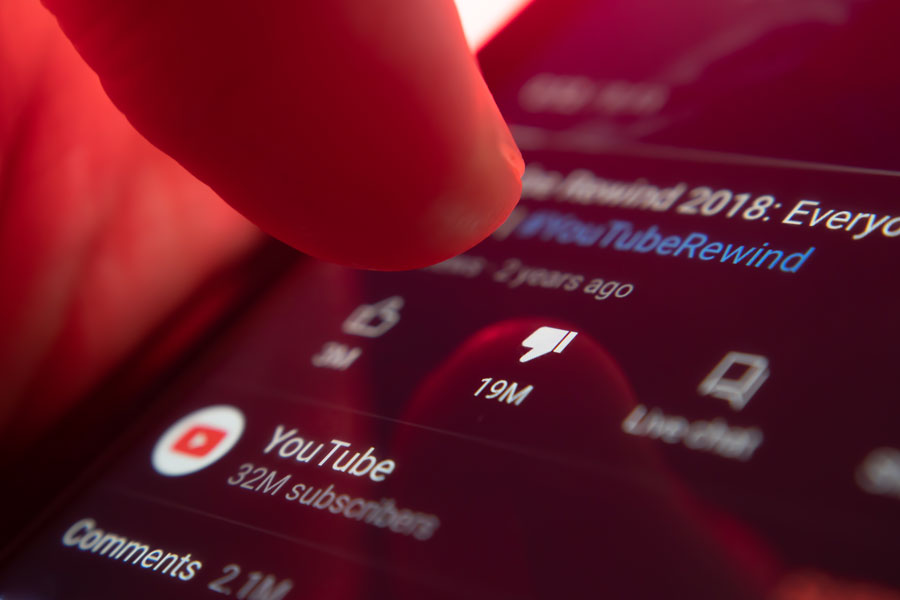
NEW YORK, NY – In early 2021, shortly after President Joe Biden took office, YouTube viewers began noticing that official White House and administration-related YouTube channels-such as The White House and Joe Biden-were drawing unusually high numbers of dislikes on almost every video, often far exceeding the likes.
From March through November 2021, even routine uploads like press briefings, vaccine updates, and speeches were consistently “ratioed,” with screenshots and data posted across social platforms showing the trend continuing for months. Then, in November 2021, YouTube announced a platform-wide decision to hide public dislike counts, saying the move would help reduce harassment and protect creators from coordinated dislike attacks.
Critics, however, argued that the timing appeared to shield the administration and other unpopular channels from visible negative feedback. Today, the dislike button still functions privately-affecting a viewer’s own recommendations-but only channel owners can see total dislikes in YouTube Studio.
The sequence of events left many observers believing that, while YouTube’s stated intent was moderation and safety, the policy change coincided closely with the period when Biden-related videos were receiving overwhelming negative ratios.
In late September 2025, Alphabet (YouTube’s parent company) told Congress it would open a pathway back for creators banned under COVID-19 and election-misinformation rules that are no longer in effect. Newsrooms report this as a phased “second-chance” pilot: bans tied to deprecated policies may be reconsidered, while bans for copyright or severe misconduct remain permanent. Specific mechanics (eligibility, monetization) are still developing.
That policy shift follows YouTube’s broader de-escalation: it retired its specific election-fraud policy in 2023 and sunset parts of its COVID-misinformation regime in 2024, handling health claims under general medical-misinformation rules. If the platform is re-normalizing its rulebook, visibility into audience feedback-dislikes included-should be part of the recalibration.
Why The Public Dislike Count Matters
Public dislike data isn’t just a vanity figure. It’s a fast, crowd-level signal users use to judge tutorial quality, product reviews, and news credibility-especially when they don’t have time to parse lengthy comment threads. That demand didn’t vanish when YouTube hid the number. For instance, the “Return YouTube Dislike” browser extension grew precisely to supply a proxy for what viewers felt they’d lost. If millions of users are recreating a metric, there’s clearly utility in restoring it natively.
YouTube’s Rationale—Then And Now
YouTube’s 2021 blog post cited internal experiments and the goal of reducing coordinated harassment. Those goals are legitimate. But hiding a signal is not the same as preventing brigading; it mostly obscures what happened from the public while creators still see the damage. A modernized approach could pair measured transparency with better anti-abuse tooling rather than suppressing a widely used quality indicator.
A Practical Way To Bring It Back
While less than ideal, a full platform-wide flip back may be unnecessary. YouTube could:
- Offer a creator-level toggle to show public dislikes.
- Pilot category-based visibility (e.g., how-to, tech reviews, news).
- Display a ratio bar (like vs. dislike proportion) instead of raw numbers to dampen brigading incentives.
- Layer in anomaly detection and limits that automatically down-weight coordinated spikes.
These steps would align with the platform’s 2025 movement toward more open discourse while maintaining guardrails.
Timeline: From Hidden Dislikes to “Second-Chance” Reinstatements
- Nov. 10, 2021 – Dislike counts hidden: YouTube makes public dislike tallies private across the platform; button remains, creators see counts in Studio.
- 2023 – Election policy retired: YouTube retires its specific policy on post-election fraud claims, shifting toward general enforcement.
- 2024 – COVID policy retired: Elements of the COVID-misinformation policy end; medical claims move under broader health-misinformation rules.
- Sept. 23–24, 2025 – Reinstatement pathway announced: Alphabet tells Congress YouTube will allow applications from channels banned under now-deprecated policies; coverage describes a phased “second-chance” pilot.
- Oct. 9–11, 2025 – Pilot details expand: Follow-on reporting outlines the pilot’s contours (eligibility limits; copyright/egregious cases excluded).
Key Facts & Details
| Item | Current Status / Facts | Sources |
|---|---|---|
| Public dislike count | Hidden since Nov. 10, 2021; button still exists; creators see private counts | blog.youtube |
| Reason cited in 2021 | Reduce harassment/brigading via private counts | blog.youtube |
| Policy environment shift | Specific election (2023) and COVID (2024) misinformation policies retired; enforcement now via general rules | AP News |
| 2025 “second-chance” program | Phased pilot lets some banned creators apply to return if bans tied to policies no longer in effect; details evolving | AP News |
| Not eligible | Copyright/Creator Responsibility violations remain permanently ineligible | The Verge |
| User demand signal | Third-party tools restore/estimate dislike stats; strong adoption | Chrome Web Store+1 (6,000,000 users) |
YouTube is already unwinding its most aggressive pandemic-era rules. Restoring some form of public dislike transparency would be a logical, low-risk next step that benefits viewers, honest creators, and overall content quality. If transparency is the goal for the rulebook, it should be the goal for feedback signals, too. The platform doesn’t have to choose between safety and openness-it can implement targeted protections while giving the public back a clearly useful metric.


